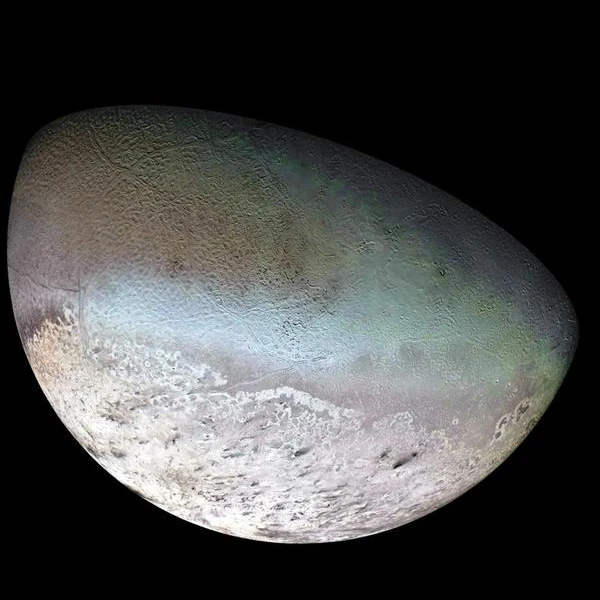
Triton was discovered in 1846 by British astronomer William Lassell (1799–1880), only 17 days after Neptune’s discovery. It is the planet’s largest satellite, with an average radius of \(R = 1,353\ \mathrm{km}\) and a mean density of \(\rho \approx 2.06\ \mathrm{g.cm^{-3}}\), indicating a mixture of ice and silicates. Triton orbits Neptune at a mean distance of \(a = 354,800\ \mathrm{km}\) and has a remarkable feature: its motion is retrograde, opposite to the planet’s rotation.
Triton’s retrograde motion, combined with its orbital inclination (157°) and high density, suggests it did not form around Neptune but is a captured object from the Kuiper Belt. Dynamical simulations show that a three-body interaction or a collision with a primitive Neptunian satellite could have slowed Triton enough to be gravitationally trapped. This capture scenario likely disrupted Neptune’s original satellite system, leading to the ejection or destruction of earlier moons.
During the Voyager 2 flyby in 1989, Triton’s surface appeared surprisingly young, with very few impact craters. The surface displays nitrogen ice plains crisscrossed by fractures, bright polar caps, and circular structures suggesting active cryovolcanism. Several plumes up to 8 km high were photographed, evidence of nitrogen gas eruptions from subsurface layers warmed by solar radiation.
Triton has a tenuous atmosphere mainly composed of nitrogen (\(N_2\)) with traces of methane (\(CH_4\)) and carbon monoxide (\(CO\)). Surface pressure is about \(1.4\ \mathrm{Pa}\), roughly 70,000 times lower than Earth’s. The mean temperature is around \(38\ \mathrm{K}\) (–235 °C), making it one of the coldest bodies in the Solar System. Recent observations suggest seasonal variations due to sublimation and condensation of polar nitrogen frost.
Hydrostatic equilibrium models indicate that Triton is differentiated, with a dense rocky core surrounded by a mantle of water ice. Residual heat from radioactive decay and ancient tidal forces may maintain a partially liquid internal ocean, possibly containing ammonia (\(NH_3\)) acting as an antifreeze. If this ocean still exists, it could provide a potentially favorable environment for prebiotic chemistry.
| Moon | Planet | Diameter (km) | Density (g/cm³) | Average temperature (°C) | Atmosphere | Physical features |
|---|---|---|---|---|---|---|
| Ganymede | Jupiter | 5268 | 1.94 | -163 | Oxygen (trace) | Largest moon in the Solar System, intrinsic magnetic field |
| Titan | Saturn | 5150 | 1.88 | -179 | Nitrogen, methane | Atmospheric density greater than Earth’s, hydrocarbon lakes |
| Callisto | Jupiter | 4820 | 1.83 | -139 | Oxygen (trace) | Heavily cratered surface, weak internal differentiation |
| Io | Jupiter | 3643 | 3.53 | -143 | Sulfur, sulfur dioxide | Active volcanism, interior heated by tidal forces |
| Europa | Jupiter | 3122 | 3.01 | -160 | Oxygen (trace) | Global subsurface ocean, smooth fractured ice surface |
| Triton | Neptune | 2707 | 2.06 | -235 | Nitrogen, methane (thin) | Retrograde rotation, active cryovolcanism, young icy surface |
| Titania | Uranus | 1578 | 1.71 | -203 | — | Tectonic faults, evidence of past internal warming |
| Oberon | Uranus | 1523 | 1.63 | -203 | — | Dark, cratered surface, mixed ice/rock composition |
| Charon | Pluto | 1212 | 1.70 | -220 | Nitrogen (trace) | Synchronous rotation, canyons, ancient cryovolcanism |
| Enceladus | Saturn | 504 | 1.61 | -201 | Water vapor (plumes) | Cryovolcanic jets, salty internal ocean, geothermal activity |
Sources: NASA / JPL – Voyager 2 Mission, ESA – Science Data.
Triton is a prime target for planetary exploration: its young surface, cryovolcanic activity, and captured nature make it a unique laboratory for understanding geological processes in the outer Solar System. The Trident mission proposed by NASA aims for a detailed flyby around 2038 to characterize its atmosphere, topography, and assess the presence of a subsurface ocean.